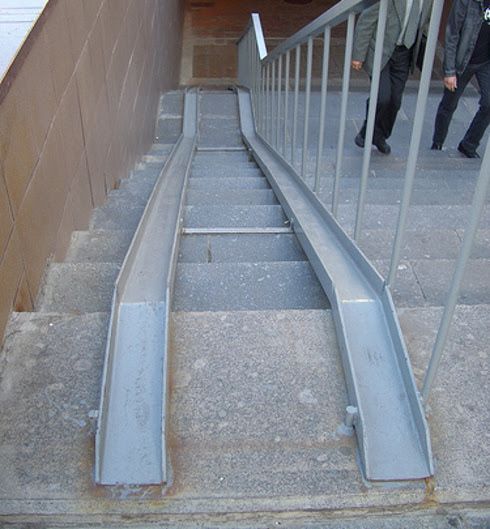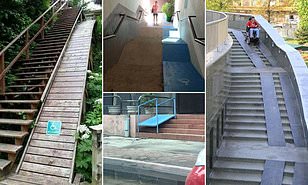Good Monday to you good peoples, and it’s time for another blog that has a little think about travel and life. And today I wanted to chat about the sort of features which make destinations good for those who struggle to get around as easily as perhaps you or I, depending on who you are that is, I’m looking at how cities make themselves accessible to those who need mobility aids as in wheel chairs and scooters.

As some may know, I work in the disability field and I must admit to always being on the lookout for issues when out and about in Melbourne that could prevent people in wheelchairs or with limited mobility accessing things. In fact I am guilty of getting someone self-righteous about this sort of stuff, which you know as I do not have limited mobility is somewhat stuck up of me to say the least. But I do support people in wheel chairs, people who need meal assistance when they eat and so on. Recently a few places have stopped taking cash due to Covid. But many I work with have no form of debit or credit card because they don’t managed their own money. I’m also annoyed by the lack disability car park spots and what seems like an over eagerness on the part of government departments to issue disability parking tags. When you park a vehicle with a wheelchair in the back you really need those spots. Working with wheelchair bound clients can physically take its toll as there is lot of pushing. Plus there needs to be easy access for someone in a wheelchair if it’s a pushed one or user operated.
I thought I would see what are considered the best cities in the world for wheel chair access. Actually getting on a plane can be a real challenge for someone in a wheel chair. If you have an electric wheelchair you can’t sit in the chair during the flight. So how do airlines get you from your chair to the seat? Apparently many lift the individual, which is problematic in many ways.
So which cities are on the list – which was compiled by Sunrise Medical FYI. Well, in Australia it turns out they considered Melbourne to be the best city in the Southern Hemisphere. What does that look like? Well I guess you want decent ramps everywhere to allow chairs into places. A single step is enough to render a place inaccessible to those in a wheelchair. So places like the museum, arts centre etc have ramps to make entry easier.

I have been to cities, especially in Eastern Europe, where I feel like they thought about it for a second and put in a ramp without thinking about it. I’m talking about ramps into and out of underpasses for example. Other cities in the world have them too. But a lot in East Europe. They are like two thin metal slides for each side of the wheelchair. And they are mounted to steps, I guess most people have seen them and not given them much thought.

Well, they are for trolleys and wheelchairs. The thing is, are they the right width for starters? They are often (but not always) only around four centimetres wide. And they are the same incline as the stairs, which is actually really steep. So steep that you couldn’t control your chair on the way down and probably someone couldn’t push you on the way up. Motor wheelchairs I would think would be too heavy as well. To me it seems like a total failure in design.

Melbourne not only has wheelchair accessible trains but many trams and buses are also wheel chair accessible. The State Government in Victoria has spent time and a lot of taxpayer money to upgrade a fair bit of the rail network, principally to raise stations above the ground – and track – so that level crossings could be removed which had been the scene of banked up and traffic and accidents for so many years. As a result every station that had to be rebuilt has lifts. It’s the easiest way for people in wheelchairs to get to the platforms. To get on the trains, well, some trains pull in nice and close to the platform which allows people in a wheel church to move into the carriage, but most trains need a ramp for access. They are kept in the front carriage so those in a wheelchair in Melbourne need to head to the top of the platform when they arrive at the station.
Some trams and buses have special doors which will load wheelchairs which is great. Also Melbourne has a fleet of “maxi-cabs” which can take up to three wheelchairs at a time.

Despite the pluses, footpaths can lack an on ramp at intersections, and quite often they are steep and hard to navigate. Footpaths are usually kept in okay condition though, especially in the centre of the city. I’ve been to cities in many countries where I just don’t know how you would get around in a wheel chair.
And these little things are huge things when you get around in a wheelchair. If the footpaths aren’t flat and even, if you can’t get on a train (think of the expense of taking a cab everywhere you want to go) and if there aren’t ramps and lifts in public buildings, well life can feel extremely limited. Things that we take for granted, like just going to a café for a coffee or a meal, can be difficult to impossible in a wheelchair without the right infrastructure.

So perhaps next time you travel, or if you’re walking around your old city, you’ll look around and think about how accessible it is. The cities mentioned as good for accessibility in the Sunrise Medical article are Washington DC, Denver, Dubai, Singapore, London, Berlin, Rome, Sydney and Melbourne. Do check it out if it interests you – Accessible Cities Around the World.
Thanks for reading today, take care, and May the Journey Never End!

I worked with Paralympic athletes for over 6 years and take note of how easy or difficult cities around the world are to navigate. Part of the problem in Canada too is the snow. Sidewalks are not high on the priority list after a snow storm. Beijing Paralympics was pretty bad. They had tight 90 corners on ramps that were too narrow for most chairs, and tall buildings in Athlete’s Village with only 1 small elevator. Unfortunately it’s not something that most cities even consider.
I hadn’t thought about the impact of snow. That must virtually imprison people for a quarter of the year in some cities.
I’ve always wondered how people with physical disabilities get around in Europe, as many places (even major cities) are NOT handicap-friendly. The Paris metro, for example, has stairs and rarely escalators/elevators (sometimes they don’t even work), and the cobblestone streets, while historic and charming, are horrible on wheelchairs and those with canes. That said, I can only imagine that those who have disabilities must have a hell of a time getting around, even just to get groceries. The US is pretty good about have ramps and accommodations for the handicapped, but there still can be a lot more improvement in all parts of the world, to make living accessible to everyone.
Old cities with infrastructure from a hundred plus years ago are always going struggle but it does need to be addressed.
Metal slides on stairs look like death traps. The U.S. legal system can encourage frivolous lawsuits but the potential for legal liability incentivizes developing and using safe methods of access for all. In countries without laws requiring equal access and that don’t impose significant liability for causing personal injury, businesses and individuals will be reluctant to change.
Sadly you are 100% on the money
Kingston, Montego Bay (the cities) and Jamaica on a whole definitely isn’t friendly to persons with mobility issues at all. I remember getting asked this about a year ago on a post, and I’ve been meaning to write an article. This reminds me! 🙂
i look forward to reading it!